 Put away your red cape.
Put away your red cape.
Forget about your alter ego.
And cancel the order on those purple spandex.
Being a hero isn’t what the comic books portray it as.
Here’s the reality:
To live heroically is to consistently commit to (and act from) the best, highest version of yourself – every day.
That’s the real superpower.
Today we’re going to another collection of ideas (read part one!) to help you become a hero to the people who matter:1. Be the example you want followed. There are four ways to influence people: Through your beliefs, through your words, through your actions and through your being.
Now, while all are effective, only the fourth is heroic. Primarily because it’s a form of embodiment, and embodiment is the highest, truest form of communication.
That’s why you can’t just set the example – you have to be the example. A walking translation. A living brochure.
That’s why Martin Luther King was such a hero to so many millions of people: He didn’t just have a dream – he was the dream. What do people think when they hear your life speak?
2. Clarify what support people can count on. The word “hero” comes from the Greek heroe, which means, “defender and protector.” Which doesn’t mean you have to punch out bad guys in back alleys.
But as a hero, it does require that you give people a continuous flow of support in the best way you can. Try these two questions I ask to clarify what kind of help people can count on:
*What’s the best way I can support you?
*How can I help you the most, right now?
Then, once people start to explain their needs, you can tailor your support accordingly. For example:
“Alright, David. Sounds like you need a night out with a friend who will listen. I’m slammed Monday and Tuesday, but you can count on me for either Wednesday or Friday. What works?”
Remember: Clarity evaporates fear. Stay with people. Even when they desert themselves. Are you using a clear, sharp and committed voice to be heard by the people who matter?
3. Courageously break stupid rules. Especially the ones that nobody had the right to create or enforce in the first place. In so do doing, three things happen.
First, you remind people that most rules aren’t really rules – they’re devices deployed to control you. To keep you average. To preserve the status quo.
Secondly, the willingness to break stupid rules demonstrates the willingness to think for yourself. And in a world where most people delegate the task of thinking to the mediocre masses, doing so is an act of heroism it itself.
Finally, being a rule breaker pulls people out of their petty preoccupations. It helps them overcome physical and psychological barriers that once stood between them and their goals.
Ultimately, it makes them look in the rear-view mirror of their life and think, “Really? That’s it? That’s what I’ve been scared of this whole time? Psht!” What stupid rules badly need to be broken?
4. Advertise your absence of hesitation. With the proliferation of steroid abuse, unsportsmanlike behavior and other character deficiencies, it’s nice to know that (some) athletes are still truly heroic.
Take Albert Polios, for example – my hometown hero. His legacy comes not from his bat, but from his battle.
The Pujols Family Foundation is a non-profit organization is dedicated to the love, care and development of people with Down Syndrome and their families; as well as the provision of medical and dental care to poor citizens of the Dominican Republic, Albert’s home country.
The best part: Albert never hesitates. On or off the field. And from his shining example, each of us could learn a few lessons. First: Heroes don’t hesitate to be pinch hitters. Whom could you go to bat for this week?
Second: Heroes don’t hesitate to be the sacrifice that would count. Are you prepared to give up something for what you know is right?
Third: Heroes don’t hesitate to play the hardest position. When your team needs a catcher during the hottest day of the year, will you step up to the plate?
Remember: He who hesitates isn’t just lost – he’s cost. What icy river do you need to suck it up and jump into?
5. Give voice to concerns that count. I recently listened to a fascinating NPR interview with actor Louis Gossett, Jr. The reporter said:
“One of the things that’s interesting about you is that you have an experience and then you often convert it into activism. Like when you were diagnosed with prostate cancer you then started talking about prostate cancer and telling people to get tested. Is that part of your own spiritual journey?”
In response, Gossett explained, “I think we all have to. It comes from the old days almost before integration. ‘Each one, teach one,’ I like to say. Because we’re on this planet not for what we can get but what we can give. And if I learn something successfully, I want to pass it on.”
What about you? I wonder experiences (that gnawed your heart away) you could use to help give voice to concerns that count. What are you turning your problems into?
6. Give yourself away. My definition of the word “hero” was forever changed when I read David Dunn’s 1943 classic Try Giving Yourself Away. To me, it was one of those books you didn’t even need to read because the title was so good.
Of course, I still read it. And loved it. Especially passages like this:
“If you start to give of yourself, be it ever so simple a fashion, the world will observe your spirit and show you many needs that you can supply. There are a hundred ways of giving away little margins of time you will never miss, which could be riches to someone.”
If that’s not a description of a hero, I don’t know what is. Lesson learned: Heroism is the ancestor of generosity. What’s your game plan for giving yourself away to the people who matter?
REMEMBER: The world will always need heroes.
From customers to employees, from children to family members and from readers to listeners, I challenge you to commit to being somebody’s hero today.
Who knows? Maybe you won’t even need those purple spandex after all.
LET ME ASK YA THIS…
To whom are you a hero?
LET ME SUGGEST THIS…
For the list called, “22 Unexpected Ways to Help People,” send an email to me, and you win the list for free!
* * * *
Scott Ginsberg
That Guy with the Nametag
Author, Speaker, Entrepreneur, Mentor
[email protected]
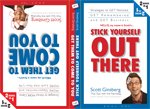 The world’s FIRST two-in-one, flip-flop book!
The world’s FIRST two-in-one, flip-flop book!
Buy Scott’s comprehensive marketing guidebook on Amazon.com and learn how to GET noticed, GET remembered and GET business!

 So, apparently, there’s a mold.
So, apparently, there’s a mold.
 Put away your red cape.
Put away your red cape.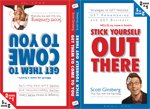 The world’s FIRST two-in-one, flip-flop book!
The world’s FIRST two-in-one, flip-flop book! Like many entrepreneurs, I go to Starbucks a lot.
Like many entrepreneurs, I go to Starbucks a lot.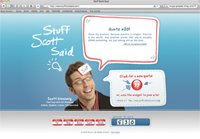 Who’s quoting YOU?
Who’s quoting YOU? “Nobody noticed if he was good looking. When Francisco d’Anconia entered a room, it was simply impossible to look at anyone else. He had a name that wiped out all others when people saw it.”
“Nobody noticed if he was good looking. When Francisco d’Anconia entered a room, it was simply impossible to look at anyone else. He had a name that wiped out all others when people saw it.” Occasionally, people will walk up to me and rip off my nametag.
Occasionally, people will walk up to me and rip off my nametag. Who’s quoting YOU?
Who’s quoting YOU? Sometimes, it sucks being the youngest one in room.
Sometimes, it sucks being the youngest one in room.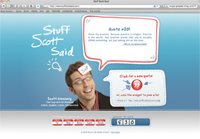 Who’s quoting YOU?
Who’s quoting YOU? As if you weren’t already assailed with enough negativity, criticism and confrontation from outside sources, I am now going to ask you to start confronting yourself.
As if you weren’t already assailed with enough negativity, criticism and confrontation from outside sources, I am now going to ask you to start confronting yourself. As if you weren’t already assailed with enough negativity, criticism and confrontation from outside sources, I am now going to ask you to start confronting yourself.
As if you weren’t already assailed with enough negativity, criticism and confrontation from outside sources, I am now going to ask you to start confronting yourself. This is all Google’s fault.
This is all Google’s fault.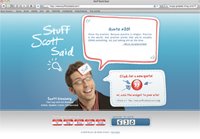 Who’s quoting YOU?
Who’s quoting YOU?